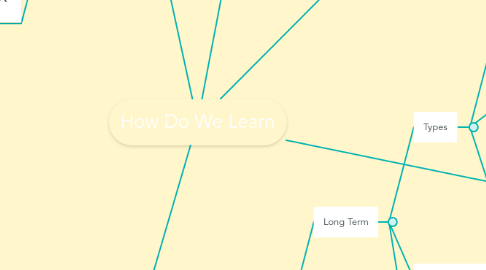
1. Amygdala
1.1. Processes information from sensors
1.1.1. STRESS
1.1.1.1. Fight or Flight
1.1.2. NO STRESS
2. Types of Memory
2.1. Long Term
2.1.1. Types
2.1.1.1. Episodic
2.1.1.1.1. Declarative Knowledge
2.1.1.1.2. Personal Experiences
2.1.1.2. Semantic
2.1.1.2.1. Declarative Knowledge
2.1.1.2.2. Facts, Concepts, and Problem Solving
2.1.1.3. Procedural
2.1.1.3.1. Metacognition
2.1.1.3.2. The "how" of Knowing
2.1.1.3.3. Ability to Perform Task as Series
2.1.2. Changed By Structural Changes of the Brain
2.1.3. How to Encode
2.1.3.1. Amount of Time
2.1.3.2. Depth of Processing
2.1.3.3. Organize Information (Schemata)
2.1.3.4. Elaboration of Information
2.2. Short Term
2.2.1. Working Memory
2.2.1.1. Patter
2.2.2. Changed By Chemical Changes of the Brain
2.3. Sensory
2.3.1. Receives Information From Environment
2.3.1.1. Visual Stimulus
2.3.1.2. Auditory Stimulus
2.3.1.3. Tactile Stimulation
3. Parts of Brain
3.1. Hippocampus
3.1.1. Neuroplasticity Throughout Life
3.1.1.1. Neurogenesis
3.1.1.2. Strengthening
3.1.1.3. Pruning
3.1.1.4. Remodeling
3.1.2. Memory and Spatial Learning
3.2. Prefrontal Cortex
3.2.1. Higher Order Cognition and Executive Function
3.2.2. Neuroplasticity Through Mid-20s
4. Factors of Influence
4.1. Emotional
4.1.1. Distress Depletes Attention
4.2. Environmental
4.2.1. Distractions
4.3. Cognitive Load
4.3.1. Intrinsic
4.3.1.1. Complexity of Content
4.3.1.2. No Prior Schema
4.3.2. Extraneous
4.3.2.1. Split Attention
4.3.2.2. Redundant
5. Ways to Improve
5.1. Behavioral Strategies
5.1.1. Exercise
5.1.2. Robotics
5.1.3. Brain Stimulation
5.2. Learning Strategies
5.2.1. Deliberate Practice
5.2.2. Growth Mindset
5.2.3. Redundancy
5.2.4. Spaced Studying
5.2.5. Challenge Yourself
5.2.6. Find Something Interesting
5.2.7. Organize Information into Schema

